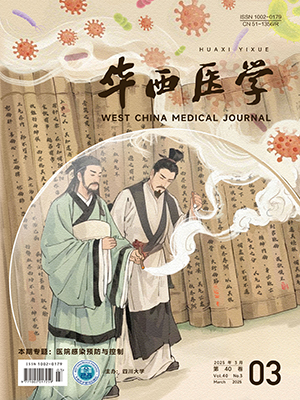| 1. |
陈国建, 杨洁, 邓艾, 等. 某综合医院常见多重耐药菌感染危险因素 logistic 回归分析. 华西医学, 2020, 35(3): 290-295.
|
| 2. |
Frieri M, Kumar K, Boutin A. Antibiotic resistance. J Infect Public Health, 2017, 10(4): 369-378.
|
| 3. |
Fussen R, Lemmen S. Prevention of transmission of multidrug resistant bacteria. Internist (Berl), 2015, 56(11): 1246-1254.
|
| 4. |
Bassetti M, De Waele JJ, Eggimann P, <italic>et al</italic>. Preventive and therapeutic strategies in critically ill patients with highly resistant bacteria. Intensive Care Med, 2015, 41(5): 776-795.
|
| 5. |
Clinical and Laboratory Standards Institute. Performance standards for antimicrobial susceptibility testing. CLSI supplement M100. 29th ed. Wayne, PA: Clinical and Laboratory Standards Institute, 2019.
|
| 6. |
胡付品, 郭燕, 朱德妹, 等. 2017 年 CHINET 中国细菌耐药性监测. 中国感染与化疗杂志, 2018, 18(3): 241-251.
|
| 7. |
胡付品, 郭燕, 朱德妹, 等. 2018 年 CHINET 中国细菌耐药性监测. 中国感染与化疗杂志, 2020, 20(1): 1-10.
|
| 8. |
黄勋, 邓子德, 倪语星, 等. 多重耐药菌医院感染预防与控制中国专家共识. 中国感染控制杂志, 2015, 14(1): 1-9.
|
| 9. |
蒲彰雅, 余治健, 陈重, 等. 利奈唑胺耐药粪肠球菌感染患者临床分离株与定植株同源性分析. 中国感染控制杂志, 2017, 16(4): 343-345, 350.
|
| 10. |
Bai B, Hu K, Zeng J, <italic>et al</italic>. Linezolid consumption facilitatesthe development of linezolid resistance in <italic>Enterococcus faecalis</italic> in a tertiary-care hospital: a 5-year surveillance study. Microb Drug Resist, 2019, 25(6): 791-798.
|
| 11. |
马孝煜, 蒲彰雅, 姚伟明, 等. 耐利奈唑胺粪肠球菌感染的危险因素分析. 微生物与感染, 2017, 12(4): 217-221.
|
| 12. |
Hu FP, Guo Y, Zhu DM, <italic>et al</italic>. Resistance trends among clinical isolates in China reported from CHINET surveillance of bacterial resistance, 2005-2014. Clin Microbiol Infect, 2016, 22(Suppl 1): S9-14.
|
| 13. |
Gomez-Simmonds A, Stump S, Giddins MJ, <italic>et al</italic>. Clonal background, resistance gene profile, and porin gene mutations modulate <italic>in vitro</italic> susceptibility to imipenem-relebactam in diverse Enterobacteriaceae. Antimicrob Agents Chemother, 2018, 62(8): e00573-18.
|
| 14. |
徐鹃鹃, 葛瑛. 碳青霉烯类耐药肠杆菌科细菌感染治疗研究进展. 中国感染与化疗杂志, 2019, 19(6): 680-686.
|
| 15. |
Lee CR, Lee JH, Park M, <italic>et al</italic>. Biology of <italic>Acinetobacter baumannii</italic>: pathogenesis, antibiotic resistance mechanisms, and prospective treatment options. Front Cell Infect Microbiol, 2017, 7: 55.
|
| 16. |
Malhotra S, Limoli DH, English AE, <italic>et al</italic>. Mixed communities of mucoid and nonmucoid <italic>Pseudomonas aeruginosa</italic> exhibit enhanced resistance to host antimicrobials. mBio, 2018, 9(2): e00275-18.
|




